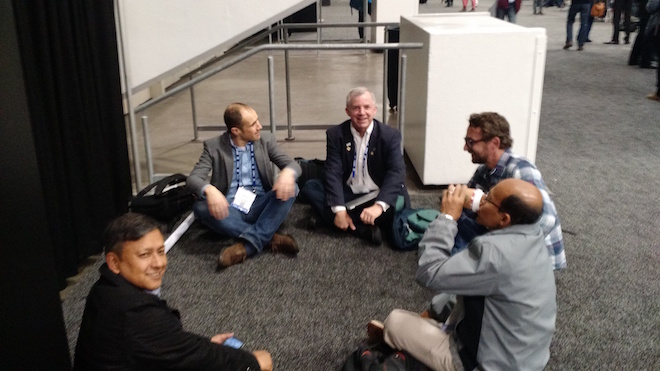Mixing, mingling and sharing ideas: SERVIR at the American Geophysical Union's Annual Fall Meeting
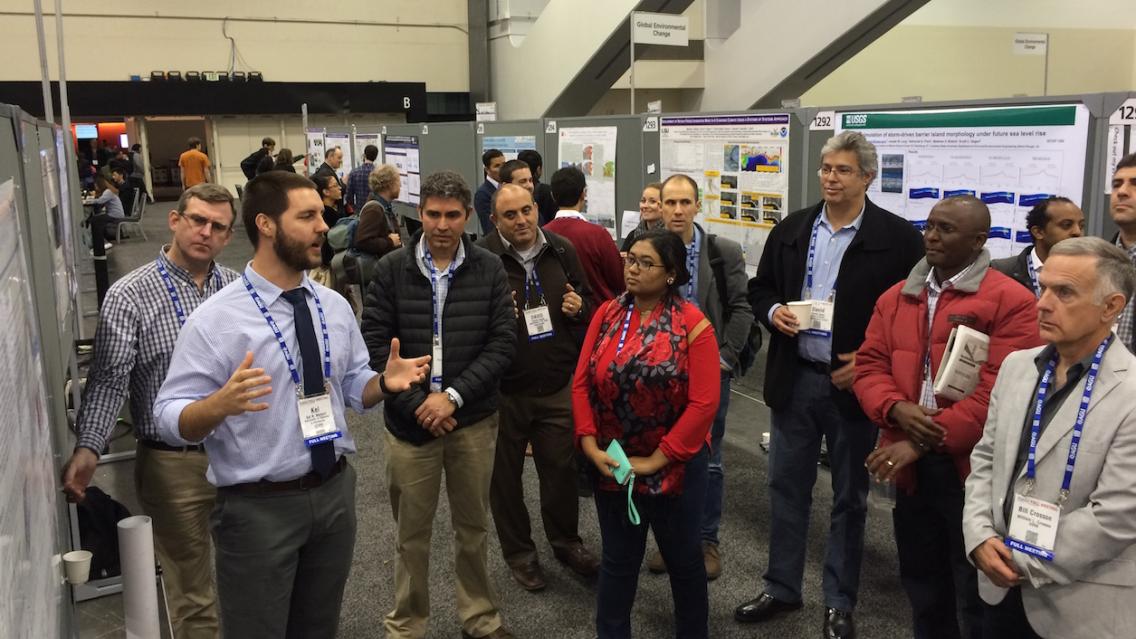
Representatives from the SERVIR Science Coordination Office (SCO), international hubs, and Applied Sciences Team (AST) traveled to San Francisco for the Annual Fall Meeting of the American Geophysical Union (AGU) 12-16 December 2016. They gave presentations, hosted poster sessions, and discussed their work and the latest advances in remote sensing for societal benefit with many of the 24,000 Earth scientists, space scientists, educators, students, and other professionals in attendance.
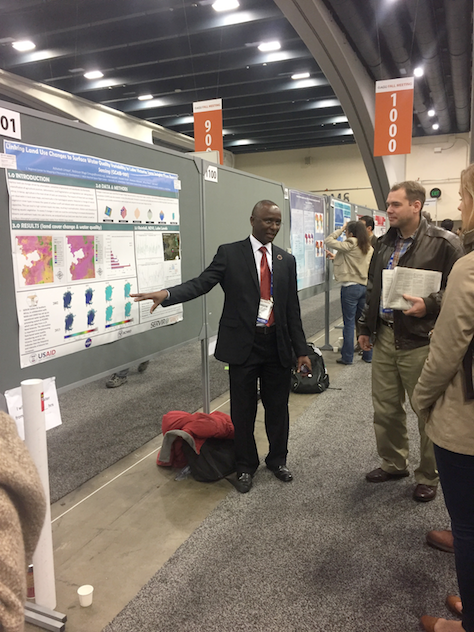 |
| SERVIR-E&SA’s Robinson Mugo explains how land cover changes may be linked to water quality in Lake Victoria |
Robinson Mugo of SERVIR-Eastern & Southern Africa (E&SA) co-chaired a well-attended Africa-focused session and presented a poster about linking land cover changes to water quality in Lake Victoria. Phoebe Odour, also of SERVIR-E&SA, gave a presentation about land cover mapping.
“We had a great time at AGU, first and foremost with our presentations, and also learning from other talks, posters, and exhibitions,” says Mugo. “The poster was featured in the ‘Climate Variability and the African Environment, Water Resources, and Food Security’ poster session. This was one of the most exciting poster presentations I have ever made. My audience was very engaging, and I enjoyed their insightful questions and interactions. Particularly, I remember one gentleman who interacted with me for close to 20 minutes, seeking to understand all the fine details of the poster. This morning, I received some papers from a professor in Sydney, who spent some minutes at my poster.”
The SCO’s Emily Adams teamed with her colleague Rebekke Muench to present a poster session about using story maps to communicate SERVIR’s work.
“It was incredible to see scientists from all over the world come together,” says Adams. “One of the most interesting things for me were the conversations with visitors at my poster session and during other sessions I took part in. We talked a lot about the growing demand for scientists to effectively communicate to the public about our work.”
Adams’ poster in fact described an effective science communication tool – story maps – which many of the SERVIR hubs have been using.
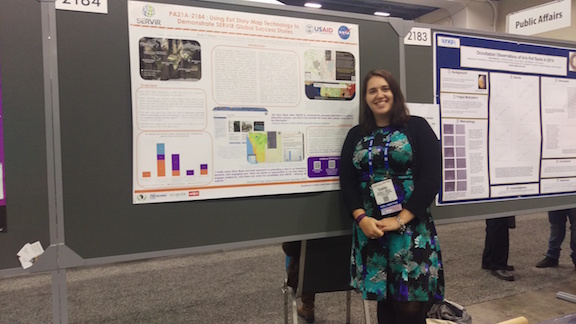 |
| SERVIR SCO’s Emily Adams hosts a poster session on story maps |
“Most of the people I spoke to during my poster session were surprised to know that I was not a communications specialist, but rather a scientist who has developed her communication skills,” she comments.
The SCO’s Bill Crosson and Eric Anderson partnered with Mir Matin and Birendra Bajracharya of SERVIR-Himalaya and David Ganz and Peeranan Towashiraporn of SERVIR-Mekong/Asian Disaster Preparedness Center in giving an oral presentation and poster session entitled “Use of Earth Observations in Mitigating Major Environmental Challenges in South and Southeast Asia.”
“To me, the AGU meeting was great as a venue to meet up with other researchers, see their presentations, and discuss similarities and possible synergies between those works and SERVIR,” notes Towashiraporn. “More importantly for SERVIR, since most of the SERVIR Applied Sciences Team scientists were there, it was a great place for us to have face-to-face meetings.”
Anderson enjoyed some of the landslide oral presentations and posters: “One of the posters was about landslide monitoring in Alaska led by Margaret Darrow of University of Alaska, Fairbanks. She and her colleagues linked field measurements with a new field of remote sensing, synthetic aperture radar (SAR), that we are interested in. This project was exciting because they worked with the Alaska Department of Transportation to inform them about the threat the landslide is posing to highways and pipelines. I think we could apply several of the new techniques and lessons presented in SERVIR regions.”
The SCO’s Kel Markert was intrigued by all of the poster sessions: “There was a lot of good research being done, and it was really fun to walk around looking at all of the posters and just talk about science. I found some projects that were pertinent to SERVIR and made sure to talk to the authors and spread the good word of SERVIR. Pete Cutter (from SERVIR-Mekong) and I connected with one of them and exchanged emails for flood forecasting applications within the Mekong region using Jason-2 and MODIS data. There was a lot of really cool and novel research being done on flood modeling and mapping and the social implications of floods. I am bringing back some good ideas to SERVIR from that.”
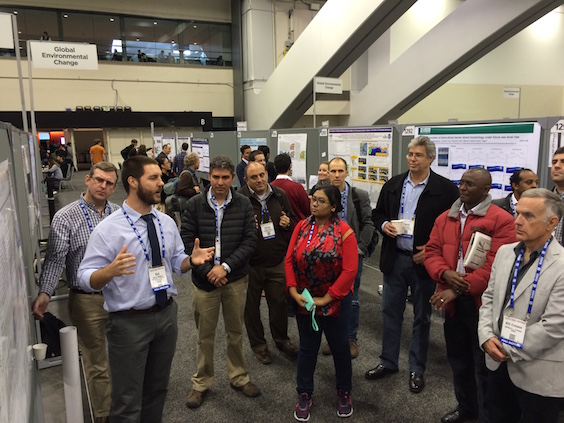 |
| Markert during the poster session |
Also participating in AGU from SERVIR were the SCO’s Ashutosh Limaye, Lee Ellenburg, and Begum Rabeya Rushi of the SCO, David Saah, Senaka Basnayake, and Rishiraj Dutta from SERVIR-Mekong with Bui Than from Vietnam National University, and SERVIR ASTs Ben Zaitchik, Jim Nelson, Cedric David, and John Bolten.
NOTE:
AGU, based in Washington DC, is an international non-profit scientific association with more than 60,000 members, and is dedicated to advancing Earth and space sciences. As the largest worldwide geophysical sciences conference, the AGU Fall Meeting gives attendees a venue in which to present their research, communicate with colleagues, and learn about the latest progress in the geophysical arena.


